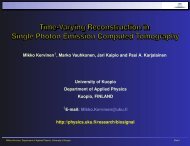Karjalainen, Pasi A. Regularization and Bayesian methods for ...
Karjalainen, Pasi A. Regularization and Bayesian methods for ...
Karjalainen, Pasi A. Regularization and Bayesian methods for ...
You also want an ePaper? Increase the reach of your titles
YUMPU automatically turns print PDFs into web optimized ePapers that Google loves.
16 1. Introduction<br />
deterministic signal in independent additive background noise of zero mean.<br />
However, <strong>for</strong> over three decades it has been evident that the nature of evoked<br />
potentials is more or less stochastic. In particular, the latencies <strong>and</strong> the amplitudes<br />
of the peaks in the potentials can have stochastic variation between the<br />
repetitions of the stimuli [22]. In addition the variations can be trend-like <strong>and</strong><br />
the means of the latencies or the amplitudes can change during the test. The<br />
in<strong>for</strong>mation about these kinds of variations in evoked potentials vanishes when<br />
the signal is averaged. The resulting estimates <strong>for</strong> the potentials possibly do not<br />
correspond to any physical or neuroanatomical situation <strong>and</strong> thus inference about<br />
the neurophysical structure is difficult. A concrete example is the use of average<br />
evoked potentials in source estimation, the estimation of the location <strong>and</strong> other<br />
parameters of the electrical sources in brain.<br />
Statistically the average evoked potential, the sample mean, is an example of<br />
the use of the first order statistics, in which only the first moment of the population<br />
parameters is estimated. The next evident improvement is to use the second<br />
order statistics, that is, covariance analysis. Typical examples of the second order<br />
<strong>methods</strong> are e.g. principal component analysis [90] <strong>and</strong> factor analysis [173] of the<br />
potentials. With these <strong>methods</strong> also a measure of the variation of the potentials<br />
can be obtained. However, also with these <strong>methods</strong> the in<strong>for</strong>mation carried by<br />
a single measurement is lost. Also all the in<strong>for</strong>mation about the time variation<br />
between the repetitions of the test is lost.<br />
Currently the goal in the analysis of the evoked potentials is to get in<strong>for</strong>mation<br />
about single potentials e.g. obtain the best possible estimate <strong>for</strong> a single potential.<br />
The notion of single trial analysis can be used in this context. The most common<br />
way to do single trial analysis is to <strong>for</strong>m an estimator (filter) with which the<br />
unwanted contribution of the on-going background activity can be filtered out<br />
from the evoked potential. A major difficulty in this task is often the very low<br />
signal-to-noise ratio, typically SNR < −10 dB.<br />
In any such filtering or estimation method the per<strong>for</strong>mance of the estimator<br />
depends on the properties of the underlying signals. In the most realistic <strong>methods</strong><br />
some models <strong>for</strong> the measurements <strong>and</strong> the signals are assumed. The estimator<br />
that yields the minimum mean square criterion is then derived. The per<strong>for</strong>mance<br />
of the estimators then depends strongly on how realistic the assumptions are.<br />
The most common assumptions concern the second order statistics of the evoked<br />
potentials <strong>and</strong> the on-going background EEG. In addition, we sometimes have<br />
prior in<strong>for</strong>mation about the evoked potentials. The in<strong>for</strong>mation can relate e.g. to<br />
the shape or the location of the peaks in potential. Generally, we should take this<br />
prior in<strong>for</strong>mation into account to obtain best possible estimates.<br />
In literature we can find two approaches to take the prior in<strong>for</strong>mation or<br />
beliefs about the parameters (signal) to be estimated into account. The first<br />
is the <strong>Bayesian</strong> approach with which the prior in<strong>for</strong>mation can be taken into<br />
account in the statistical sense. This procedure usually necessitates some prior<br />
statistical in<strong>for</strong>mation about the parameters in the <strong>for</strong>m of prior distributions.<br />
The other approach, the use of the regularization <strong>methods</strong>, arises from the field of<br />
ill-posed problems. In this class of the <strong>methods</strong> the prior in<strong>for</strong>mation about the





